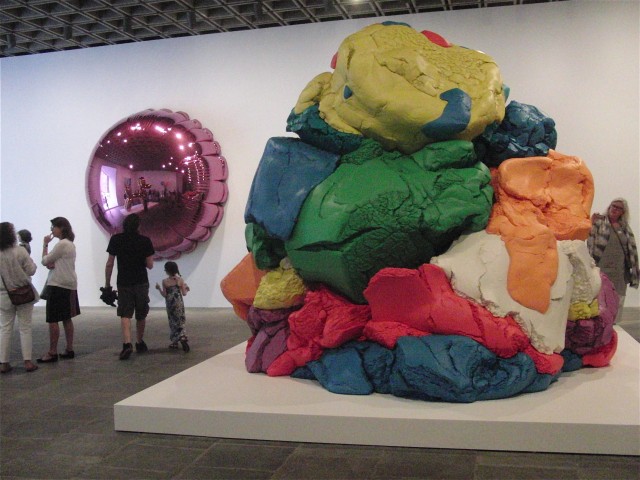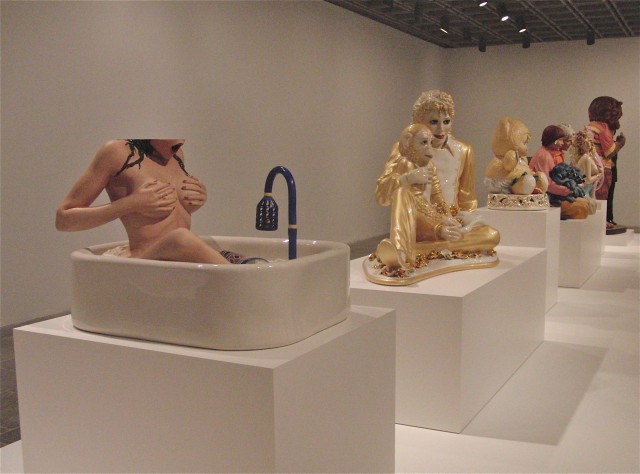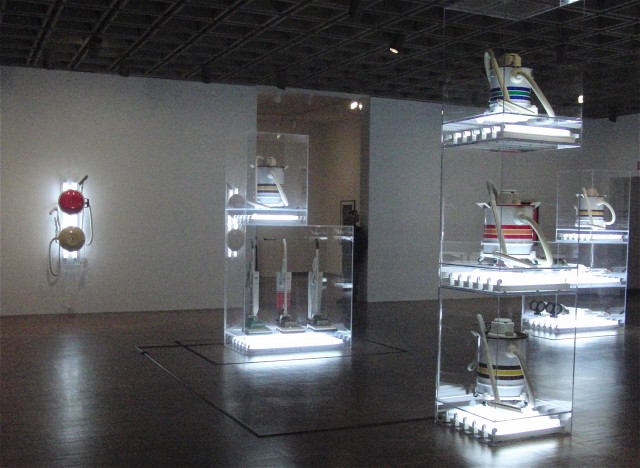
Jeff Koons, “Moon (Light Pink),” mirror-polished stainless steel with transparent color coating, 1995-2000, and “Play-Doh,” polychromed aluminum, 1994-2014 (photo by twi-ny/mdr)
Whitney Museum of American Art
945 Madison Ave. at 75th St.
Through Sunday, October 19, $16-$20 (pay-what-you-wish Fridays, 6:00 – 9:00)
212-570-3600
www.whitney.org
Perhaps no other living contemporary artist elicits such a vast range of emotions and responses at the mere mention of his name than Jeff Koons. For three dozen years, Koons has been giving the people what they want while confounding and angering his many, many critics. “From the beginning, Jeff Koons provoked superlatives. Mere adjectives seemed insufficient to describe the jolt of his art — and soon him,” curator Scott Rothkopf writes in his essay “No Limits” in the catalog for the museumwide exhibition “Jeff Koons: A Retrospective,” which runs through October 19 at the Whitney. “As far as art and artists are concerned, shock, fame, expense, controversy, subversiveness, and ambition are certainly not accepted unanimously as virtues. Finally, it must be said that not one of these claims . . . could be verified as true.” From a purely aesthetic point of view, Koons’s vast oeuvre, primarily works in series that often involve the readymade, is colorful and engaging, inviting and personable, even as it induces even the least jaded individual to wonder, “But is it art?” Accepting it as art without question, I found myself, as I walked through the retrospective, transported back to my childhood, happily besieged by recollections popping into my head that I hadn’t thought about for years. “Unlike many artists, for whom a conventional American hometown was a place to escape, Koons continues to draw on his boyhood home of York, Pennsylvania, as a primary source of inspiration,” writes Jeffrey Deitch in his catalog essay, “York to New York,” adding, “The city has remained central to his life as an artist, and he returns there almost every weekend. Koons retains an extraordinary ability to access his early childhood memories and build on them in creating his art. He can recall childhood visions and the emotions that accompanied them as if they are happening in the present. He claims even to remember being in his crib. Koons is able to experience these images not just as fleeting memories but as deep aesthetic structures that can be channeled into artistic form.”
For me, winding my way through the nearly 150 paintings, sculptures, and installations was an immensely pleasurable journey into my own past. Koons’s vacuum-cleaner pieces, such as “New Hoover Convertibles Green, Blue, New Hoover Convertibles Green, Blue Doubledecker,” from his 1980s series “The New,” had me back in the den, trying to hear my favorite Saturday-morning cartoons as my mother vacuumed the house, while the lithograph-on-cotton billboard “New Rooomy Toyota Family Camry” reminded me of when my father came home with a new Dodge Charger. Koons’s “One Ball,” “Two Ball,” “Three Ball” works featuring basketballs suspended in water tanks, from the “Equilibrium” series, reminded me of when we realized that my father had put up our backyard basketball hoop too high, at more than ten feet. The “Luxury and Degradation” series of oils consists of reproductions of booze ads, along with a stainless-steel ice bucket and “Travel Bar,” that sent me back to memories of my friends and I raiding my parents’ liquor cabinet when they were away. Polychromed wood and porcelain figures from the “Banality” series — Koons’s series titles are another important part of his own self-evaluation, intentions, and art-historical references — had me thinking of the tchotchkes my mother collected and displayed in the living room. And “Made in Heaven,” comprising revealing paintings and sculptures of Koons having sex with Hungarian-born Italian porn star and politician Illona Staller — shortly thereafter they were married, had a son, and then divorced — sent me back to the day I found my father’s hidden stash of Playboy magazines and Swedish blue movies.

Jeff Koons’s “Banality” series offers different views of domesticity and life as kitsch (photo by twi-ny/mdr)
Of course, Koons’s recurring use of animals and toys, including stainless-steel balloon dogs, a bronze Hulk, an inflatable bunny, a granite gorilla and Popeye, an oil painting of a slice of birthday cake, and an adorable (if crucifixion-like) polyethylene cat on a clothesline, evoke more universal childhood memories. In addition, many of his works involve mirrors and mirror-polished stainless steel, from the enormous balloon dogs to crystal-glass depictions of the heads of a giraffe, a kangaroo, a walrus, and other animals, as well as the lovely “Hanging Heart (Violet/Gold)”; children and adults flock to see their reflections in these pieces and take pictures of themselves in them, as if they are part of the exhibition, at least for a moment, creating new (digital) memories. However, despite their seemingly overt simplicity, much of Koons’s output took years to fabricate, as new machination procedures had to be developed in order for them to come into existence. Wall text highlights fascinating details about Koons’s construction techniques, adding a level of depth to works that are often ridiculed as simplistic and, well, banal. The centerpiece of the show, and perhaps the single piece that is most representative of Koons’s mind-set, is “Play-Doh” (1994-2014), a large-scale polychromed-aluminum rendition of multiple blobs of different-colored Play-Doh reaching ten feet high and nine feet wide. “‘Play-Doh’ is a deceptively simple sculpture,” Rothkopf explains on the audio guide. “I say ‘deceptive’ because it’s one of the most technically challenging objects in the entire exhibition and one that Koons has been working on for twenty years and completed, in fact, just in June. The idea for this work originally came about out of a mound of Play-Doh that his son, Ludwig, made. Koons talks about his interest in this object being the freedom that the child had to express himself.” That essentially sums up where Koons is coming from, a place inside himself, and each of us, that we all can relate to, the freedom that childhood offers. Eventually, we grow up and move on to other things, saying goodbye to childhood, which is a shame, as this retrospective — which in its own way is helping us all say farewell to Marcel Breuer’s familiar building (the Koons show is the last in the Upper East Side space, as the Whitney moves next year to a new home in the Meatpacking District, designed by Renzo Piano) — is a love letter to the glories of being a kid and retaining at least some of that innocence. The Whitney will celebrate the end of the exhibit and the closing of the building with a marathon viewing for the final weekend, remaining open from 11:00 am on Saturday, October 18, through 11:00 pm on Sunday, October 19. Koons will be at the museum on Saturday night at 9:00 to sign copies of the exhibition catalog, while Rothkopf will participate in a Q&A Saturday at midnight.
